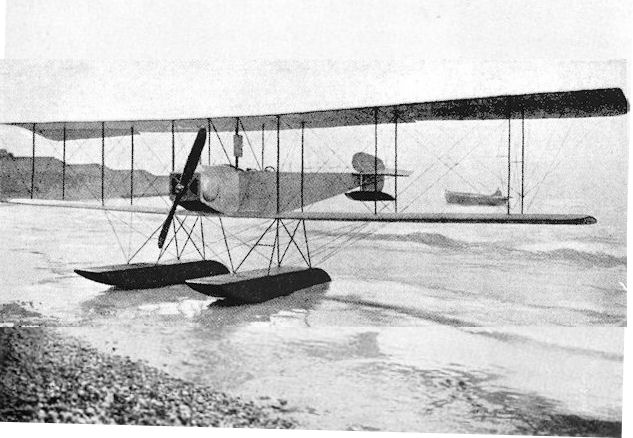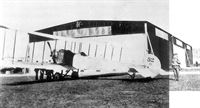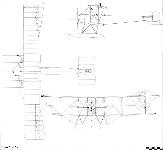
Описание
Страна: Великобритания
Год: 1913
Варианты
- Avro - 501 - 1913 - Великобритания
- Avro - 503/Type H - 1913 - Великобритания
- Gotha - WD.1/WD.2 - 1914 - Германия
- Gotha - WD.5/WD.9 - 1915 - Германия
- Gotha - WD.12/WD.13/WD.15 - 1917 - Германия
- A.Jackson Avro Aircraft since 1908 (Putnam)
- M.Goodall, A.Tagg British Aircraft before the Great War (Schiffer)
- P.Lewis British Aircraft 1809-1914 (Putnam)
- J.Bruce British Aeroplanes 1914-1918 (Putnam)
- H.King Armament of British Aircraft (Putnam)
- Журнал Flight
-
P.Lewis - British Aircraft 1809-1914 /Putnam/
Avro Type 503 seaplane at Shoreham in 1913 (at Brighton after acceptance tests in June, 1913 ???).
Powered by a 100hp Gnome, the Avro Type H, or 503, derived from the Avro 501 floatplane and made its first flight on 28 May 1913. Ironically this particular machine was bought by the German Navy and is seen undergoing their acceptance trials at Worthing, Sussex in June 1913. An additional three examples were built, all for the British Admiralty. Top level speed of this two-seater floatplane was 64mph at sea level. Incidentally, many of the Type H's features were to find their way into the later Gotha WD-1. -
A.Jackson - Avro Aircraft since 1908 /Putnam/
The original Avro 503 seaplane moored at Shoreham in June 1913.
-
Журнал - Flight за 1913 г.
The 100 h.p. Avro hydro-biplane on the sea, as seen from in front.
-
J.Bruce - British Aeroplanes 1914-1918 /Putnam/
The original Avro 503 float seaplane.
-
Журнал - Flight за 1913 г.
Side view of the 100 h.p. Avro hydro-biplane.
-
Журнал - Flight за 1913 г.
The 100 h.p. Avro hydro-biplane in flight.
-
A.Imrie - German Naval Air Service /Arms & Armour/
In order to evaluate current foreign marine aircraft techniques several machines were bought from other countries, including an Avro 503 seaplane from Britain. Following acceptance tests, the Avro was flown to Heligoland for the Autumn Fleet manoeuvres by Langfeld, carrying a passenger, in September 1913. This was the first flight by a seaplane from the German mainland to Heligoland. Four seaplanes were deployed in the manoeuvres, but three of them were considered unsuitable for operational use; the Avro, however, generally gave excellent results.
-
A.Imrie - German Naval Air Service /Arms & Armour/
Putzig, near Danzig, was selected as the site for the German naval Flugversuchstation (Flight Experimental Station) since it possessed a wide flat area of grassland, providing a natural land aerodrome, and a coastal area protected from rough wave conditions by the Hela peninsula, giving an excellent seaplane harbour - thus meeting both of the requirements for the operation of amphibious aircraft. The machines seen here in 1913 are the Albatros monoplane, designed by Ernst Heinkel and flown with success by Helmuth Hirth in the Bodensee Competition, and the Avro (D12) bought from Britain.
Другие самолёты на фотографии: Albatros HE Amphibian Taube floatplane - Германия - 1913
-
A.Jackson - Avro Aircraft since 1908 /Putnam/
The second RNAS Avro 503 in landplane form in service with the RNAS. No.52. at Chingford in 1915.
-
Журнал - Flight за 1913 г.
THE 100 H.P. AVRO HYDRO-BIPLANE. - Plan, side and front elevations to scale.
A.Jackson Avro Aircraft since 1908 (Putnam)
Avro 501 and Avro 503 (Type H)
The choice of Shoreham as the Avro company’s new flying ground when it moved from Brooklands in the autumn of 1912 was largely the result of Cdr Schwann’s successful waterborne experiments and Avro’s awakening interest in seaplanes. It was an ideal site with Shoreham Harbour close at hand and it was from the adjacent River Adur that the Avro Type H seaplane made its first take-off. Construction of this machine followed tests on Windermere by H. Stanley Adams in January 1913 with the Avro 501 which, apart from a considerable strut-braced top wing overhang, was similar to an enlarged float-equipped Avro 500. Built at Brownsfield Mills in November 1912 and powered by a 100 hp Gnome, the Avro 501 first flew as an amphibian with a sprung central float designed by O. T. Gnosspelius, 15 ft long and 7 ft wide from which projected three small wheels, two in the rear and one forward. With so narrow a float an aircraft with a wing span of 47 ft 6 ins could be expected to heel over when steerage way was lost, and for this reason small wing tip floats were fitted and inclined to sit squarely in the water. This arrangement proved unsatisfactory and Gnosspelius replaced it with a twin float unit without wheels which made the aircraft sufficiently seaworthy to interest the Admiralty, to whom it was eventually delivered in the Isle of Grain. In the light of experience at Barrow, the airscrew leading edges were sheathed with brass to prevent damage from flying spray and the tail float was bolted directly to the old-style sprung rudder for steering on the water.
Also powered by a 100 hp Gnome, the Type H (later known as the Avro 503), was a slightly larger version of the Avro 501 but with less mainplane overhang and no inclined struts. Following standard Avro practice, the new seaplane was built with an eye to quick dismantling and was constructed round a 9 ft centre section to which were bolted fuselage, undercarriage and outer wing panels. The upper mainplane, 3 ft greater in span than the lower, was fitted with large inversely tapered ailerons but none was fitted to the lower wing. Two-step, internally sprung floats, 14 ft long and 2 ft 6 in wide, set at a track of 6 ft 6 in, were covered with rubberised material and attached to the aircraft by 14 tubular steel struts bound with varnished fabric.
Such was his confidence in the Type H that F. P. Raynham made the first take-off from the Adur in sea mist on May 28, 1913, carrying passenger Jack (later Sir John) Alcock, two hours’ fuel and an anchor. The aircraft became airborne after a run of only 60 yards and cleared the adjacent railway bridge by 100 ft. Next day, again carrying the future conqueror of the Atlantic, Raynham made a first landing on the open sea outside Volk’s seaplane hangar opposite Paston Place, Brighton. A float was damaged on take-off so a landing was made in Shoreham Harbour where the aircraft was hastily beached. After some local strengthening of the nose of each float the machine was out again on June 12 and two days later Raynham made an hour’s demonstration flight over Brighton carrying Lt J. W. Seddon RN, Inspector of Naval Aircraft. Despite the weight and drag of the floats, the Type H climbed to 1,300 ft in 5 minutes.
The Avro 503 was then flown by Capt Schultz, a German naval officer who had made several visits to the works while it was under construction, and before the month was out the machine was purchased by the German Government, dismantled and packed for shipment. Flown by Lt W. Langfeld it became on September 3, 1913, the first aircraft to cross the 40 miles of North Sea from Wilhelmshaven to the Island of Heligoland, a successful return trip to Cuxhaven being made on September 15. An Avro 503 seaplane was also ordered by the Peruvian Government but the outbreak of the First World War prevented delivery and it is believed to have been turned over to the British Admiralty.
Three other 100 hp Gnome-powered Avro 503s were built - all to Admiralty order for use by the Royal Naval Air Service. The float undercarriage of the old Avro 501 having proved far too heavy, the Admiralty agreed to accept it as a landplane. A. V. Roe thereupon devised a two-wheel, twin-skid undercarriage but the track was still too narrow to support the aircraft vertically at rest and stout wing tip skids were necessary. In land-plane form, with large inversely tapered ailerons replacing the constant chord units, the Avro 501 was so quaint a structure that it soon earned the name ‘Rickety Ann’. After delivery to Eastchurch it had to be lightened and several airscrews tried before F. P. Raynham could complete the acceptance tests. Bearing naval serial 16 it was flown to Shoreham on June 2, 1913, by Raynham with Lt Seddon as passenger.
The first RNAS Avro 503 seaplane, 51, was delivered in crates to the Isle of Grain on September 8, 1913. It easily passed its RNAS trials there on September 25, 1913, when, piloted by F. P. Raynham, it reached a speed of 64 mph and climbed to 3,000 ft in 19 minutes with full tanks (36 gallons of petrol and 10 gallons of oil giving 4 hours’ endurance) while carrying a passenger and wireless equipment. The second machine, 52, was delivered to the Isle of Grain on October 7, 1913, and the third, 53, on October 15, 1913. This last machine incorporated some undefined improvements. All three machines were later converted to landplanes and were in use at Eastchurch in September 1914. No. 52 remained active until January 1916.
SPECIFICATION AND DATA
Manufacturers: A. V. Roe and Company (reconstituted as A. V. Roe, and Co. Ltd. 11.1.13), Brownsfield Mills, Great Ancoats Street, Manchester (moved to Clifton Street, Miles Platting, Manchester 4.13); and Shoreham Aerodrome, Sussex
Power Plant: One 100 h.p. Gnome
Dimensions, Weights and Performances:
Avro 503 seaplane
Span (upper) 50ft. 6 in.
Span (lower) 47ft. 0 in.
Length 33ft. 6 in.
Height 12ft. 9 in.
Wing area 567 sq. ft.
All-up weight 2,200 lb.
Maximum speed 50 m.p.h.
Initial climb 225 ft./min
Production:
Avro 503 prototype first flown at Shoreham 28.5.13, to the German Navy 6.13 with serial D12
Three Avro 503 seaplanes with serials 51, 52 and 53 built for the RNAS and delivered to the Isle of Grain. All later converted to landplanes before September 1914. 51 crashed at Chingford 11.8.15, 52 withdrawn from use 1.16, 53 withdrawn from use at Eastchurch 11.15
Описание:











